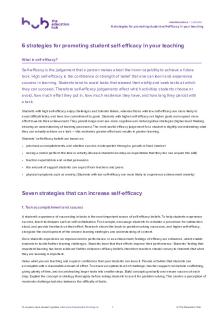Self & Collective Efficacy PDF

| Title | Self & Collective Efficacy |
|---|---|
| Author | Chelsie-Jane Mason |
| Course | Applied Sport and Exercise Psychology |
| Institution | Cardiff Metropolitan University |
| Pages | 5 |
| File Size | 729.9 KB |
| File Type | |
| Total Downloads | 62 |
| Total Views | 165 |
Summary
Download Self & Collective Efficacy PDF
Description
Self & Collective Efficacy COMPARISON OF SOURCES OF SE & SPORT CONFIDENCE
SELF EFFICACY “A belief in one’s capabilities to organize and execute the course of action required to produce given attainments” (Bandura, 1997) Theory
COLLECTIVE EFFICACY A group’s shared belief in its conjoint capabilities to organize and execute the courses of actions require to produce given levels of attainment (Bandura, 1997, p. 477)
Simply stated - Athletes’ confidence in the process of their own team. Not athletes’ confidence in team abilities to obtain a certain outcome. Characteristics Efficacy beliefs are future-oriented judgments of process Shared belief of teammates - Shared belief = high degree of agreement or perceptual concensus among member’s judgments. Less variability within teams than between teams. Depends on task interdepence Dynamic construct Team confidence-performance link with temporal proximity Perceptions of personal and interpersonal skills E.g., coordination, communication, decision making - Integrative capabilities are coordination, communication, and decision making - Low interdependence – CE is aggregation of teammembers’ selfefficacy beliefs Measure Approach 1 Collective efficacy questionnaire for Sport – CEQS Rate your team’s confidence 1. Effort (e.g., to play to its capabilities) 2. Persistence (e.g., to persist when obstacles are present) 3. Preparation (e.g., to devise a succesful strategy) 4. Unity (e.g., to be united) 5. Ability (e.g., outplay opposing team) = outcome oriented.. Approach 2 Observational Collective Efficacy questionnaire for Sport Rate your team’s confidence.... 1. To react enthuastically when making a point 2. To have leader figures in the team who believe that we will win the game 3. Players who cheer enthusiastically 4. Encourage eachother during the game 5. Communicate a lot tactically during the game More dynamic measure Effects
Sources
Total of Sources
Leaders’ Confidence in ‘us’ Inspires Performance
Strategies to Improve Verbal persuasion Team talks focused on the collective Tactical communication Leadership Display confidence Believe in ‘us’
Create mastery experiences Team simulations Mastery-based motivational climate Team goal setting
Vicarious experiences Watch video footage of own performance Watching other teams Imagery Positive support commucation Celebrate success Encourage eachother Cohesion Build task and social cohesion...
Similar Free PDFs

Self & Collective Efficacy
- 5 Pages

Career Self-Efficacy Scale
- 1 Pages

Banduras Theory of Self Efficacy
- 3 Pages

Alburt Bandura and Self Efficacy
- 3 Pages

Collective Bargaining
- 11 Pages

collective security
- 18 Pages

Collective Cabinet Responsibility
- 11 Pages

Collective Intelligence skill
- 1 Pages

L3 Collective Laissez-Faire
- 4 Pages

Collective consensus in Britain
- 1 Pages

Collective Leadership ALL Links
- 193 Pages

Collective labour law notes
- 18 Pages

Convention Collective d\'Hydro QC
- 47 Pages
Popular Institutions
- Tinajero National High School - Annex
- Politeknik Caltex Riau
- Yokohama City University
- SGT University
- University of Al-Qadisiyah
- Divine Word College of Vigan
- Techniek College Rotterdam
- Universidade de Santiago
- Universiti Teknologi MARA Cawangan Johor Kampus Pasir Gudang
- Poltekkes Kemenkes Yogyakarta
- Baguio City National High School
- Colegio san marcos
- preparatoria uno
- Centro de Bachillerato Tecnológico Industrial y de Servicios No. 107
- Dalian Maritime University
- Quang Trung Secondary School
- Colegio Tecnológico en Informática
- Corporación Regional de Educación Superior
- Grupo CEDVA
- Dar Al Uloom University
- Centro de Estudios Preuniversitarios de la Universidad Nacional de Ingeniería
- 上智大学
- Aakash International School, Nuna Majara
- San Felipe Neri Catholic School
- Kang Chiao International School - New Taipei City
- Misamis Occidental National High School
- Institución Educativa Escuela Normal Juan Ladrilleros
- Kolehiyo ng Pantukan
- Batanes State College
- Instituto Continental
- Sekolah Menengah Kejuruan Kesehatan Kaltara (Tarakan)
- Colegio de La Inmaculada Concepcion - Cebu


